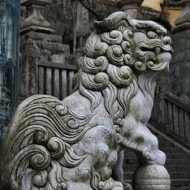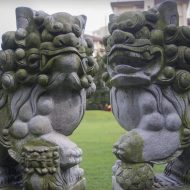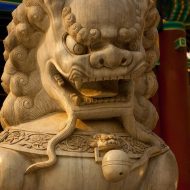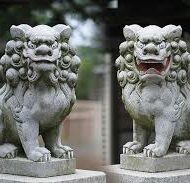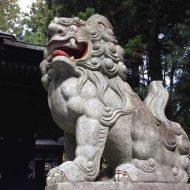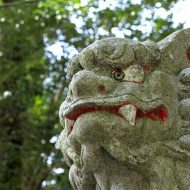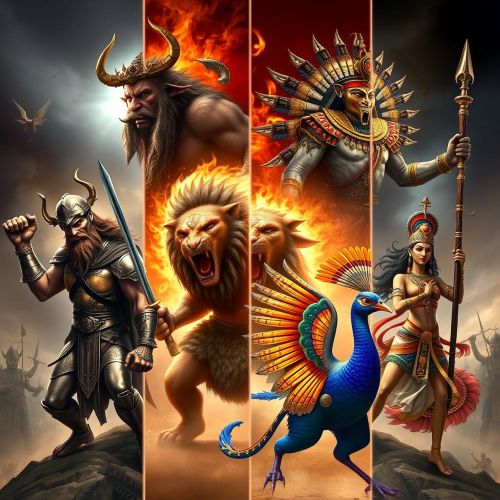Komainu : The Lion Dog
Listen
At a glance
| Description | |
|---|---|
| Origin | Japanese Mythology |
| Classification | Hybrids |
| Family Members | N/A |
| Region | Japan |
| Associated With | Protection, Temples |
Komainu
Introduction
Komainu refer to the lion statues that are commonly found at the entrances of Japanese or Shinto temples. These statues are often called lion-dogs or sand komainu. They can be found in both the outer and inner portions of Shinto shrines. The first type, born during the Edo period is called sandō komainu and the second and much older type is called jinnai komainu. They can also be found at private homes, Buddhist shrines and places associated with nobility. Modern komainu statues are almost identical, except for the mouths. In most cases, they have the same shape, though exceptions exist. Two forms are called a-gyo and un-gyo.
The name Komainu translates to Chinese guardian lions. They are believed to have been inspired by the images of Asiatic lions that were brought to China from India and the Middle East and especially from symbolism associated with Emperor Ashoka of India. The symbol of strength became a prominent feature of the animal after its transportation along the Silk Road.
Physical Traits
There are many types of komainu, such as those with coins in their mouths or on their paws. In other places, they have bibs around them like statues of Jizo and Nagasaki. Komainu are often in pairs, with one male and one female. In the Heian Period these were called komainu and the hornless ones were called shishi, lions, though nowadays both are referred to as komainu.
Modern Day
During the Nara period, which is similar to the rest of Asia, two lions always accompanied each other. These pairs were only used indoors until the 14th century. During the Heian period, the two statues were different, and the former was called “shishi” because it had open mouth, while the latter was referred to as komainu or goguryeo dog. Probably the most common form of komainu that appears nowadays are the stone ones that are guarding the approach-ways of shrines.
There are definite differences in the styles of komainu found at major shrines and rural areas, as well as the artists who create these works. There are many styles that refer to regions in Japan, some of which are very distinctive and some of which are beginning to disappear. One particular style that is becoming less popular is the Izumo style where the lions are not sitting but depicted as crouching with their rear end up in the air. The Okazaki style is considered to be the standardised style now and common all over Japan.
Similar structures are seen all across Asia especially in China, Korea, Indonesia, Cambodia, Thailand and India.
Related Images
Source
Japanese Mythology Worldwide: The Mythical Komainu: Guardian Lions of Japan. https://japanese.mythologyworldwide.com/the-mythical-komainu-guardian-lions-of-japan/
Tofugu: Komainu: The History of Japan’s Mythical Lion Dogs. https://www.tofugu.com/japan/komainu/
Wikipedia: Komainu. https://en.wikipedia.org/wiki/Komainu
Frequently Asked Questions
What does komainu symbolize?
The Komainu, mythical lion-dogs found in Japan, are potent symbols of protection, duality, strength, and wisdom. Standing guard at the entrances of shrines and temples, they ward off evil spirits with their fierce stare and symbolize both the beginning (aum) and the end (um) through their open and closed mouths. Their lion features represent royalty, power, and courage, while their watchful eyes convey wisdom and knowledge. Ultimately, the Komainu represent the powerful guardians of sacred spaces, reminding us of the importance of balance and the constant presence of divine protection.
What are the powers of a komainu?
Though their exact powers are subject to interpretation, Komainu are generally believed to possess incredible strength, longevity, and senses that allow them to detect and combat evil. Some stories even grant them the ability to speak, come alive at night, or act as intermediaries between humans and the divine. Ultimately, these mythical lion-dogs symbolize potent protection, warding off evil and safeguarding sacred spaces with their unwavering vigilance and spiritual might.
Is the komainu male or female?
There are different interpretations regarding the gender of Komainu. According to one tradition, the Komainu with the open mouth is considered male, while the one with the closed mouth is considered female. Another tradition suggests that the Komainu on the left is male, while the one on the right is female. Therefore, depending on the tradition followed, a Komainu could be either male or female.
Which komainu is male?
Although visible genitals are rare, the left one is believed to be male, the right one female. It’s also sometimes said that the open-mouthed animal is male, while the other is female. So, the male Komainu could either be the one on the left or the one with its mouth open, depending on the tradition followed.
Is komainu a dog?
Komainu, commonly known as lion-dogs in English, are mythical beings that traditionally stand guard at the entrances of Shinto shrines in Japan. Usually appearing in pairs, these creatures exhibit a distinctive blend of dog and lion characteristics.

